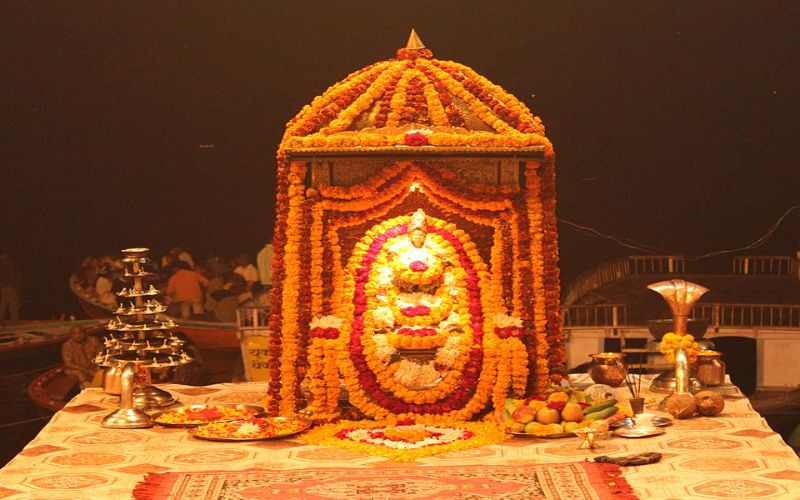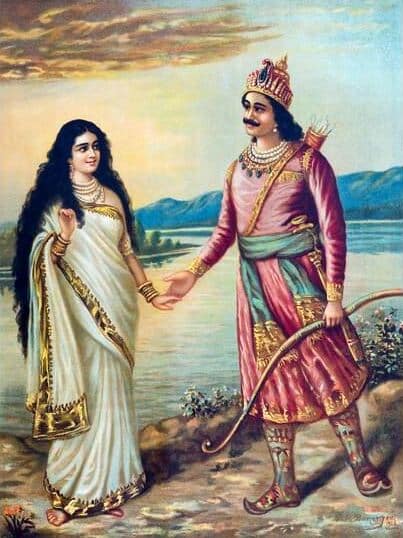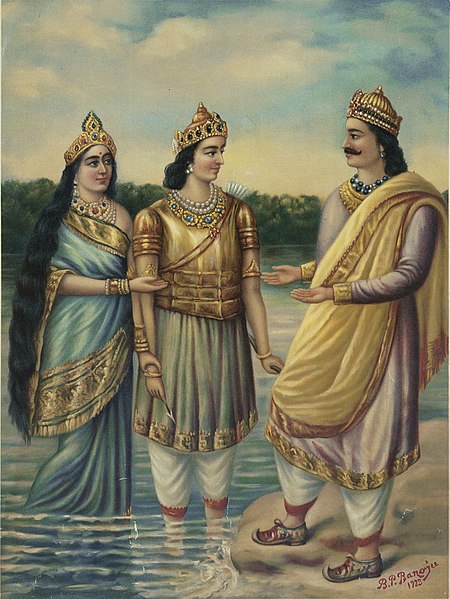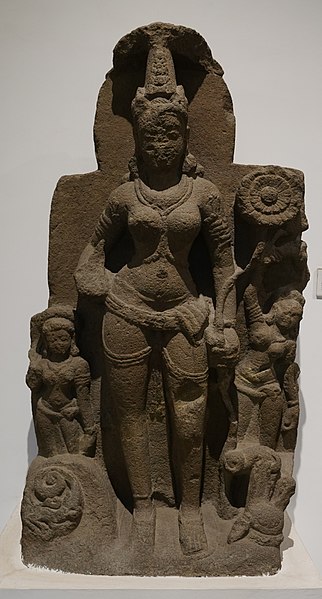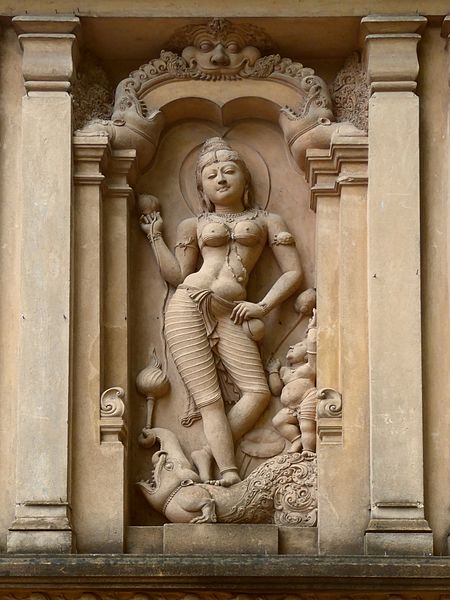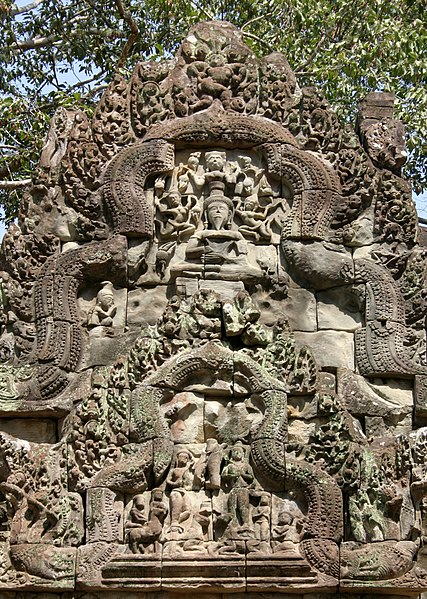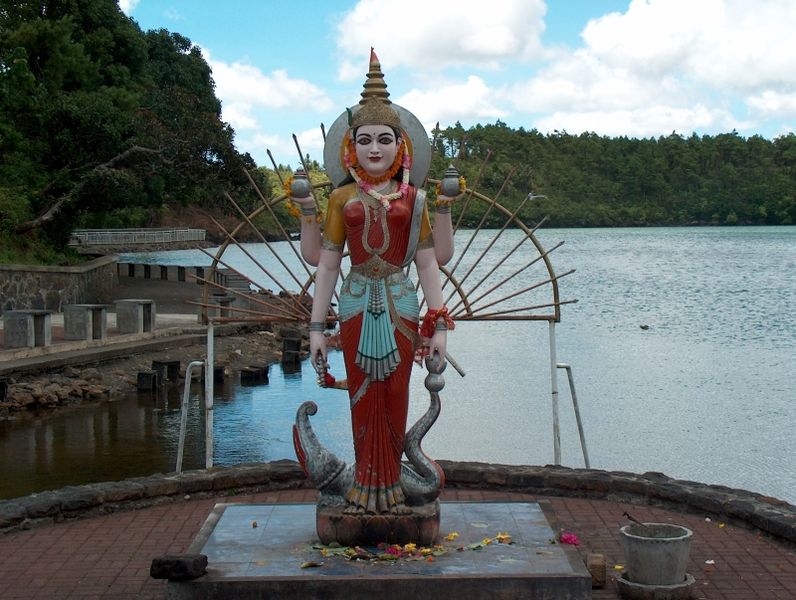In Hinduism, it is believed that divinity resides in every particle of the universe, that all animate and inanimate beings are an embodiment of the divine consciousness. That is why nature is revered and worshipped in Hindu Dharma. Trees, rivers, forests, plants, etc, these do not exist merely for fulfilling human needs but sustain the very flow of life on earth and are thus sacred to Hindus.
Rivers embody the flow of divine consciousness in Hinduism. That is why almost all major rivers of India are worshipped and there are many mythological stories associated with these rivers. Goddess Ganga or Devi Ganga is associated with Ganga, the holiest river of India. She is considered the personification of river Ganga that originates from the Gangotri glacier in the Himalayas up in the extreme north and flows through various northern and eastern states of India before merging into the Bay of Bengal.
Called Ganga Maiyya (Mother Ganga ) lovingly by her devotees, Goddess Ganga is the symbol of purification and forgiveness. She is also known by other names, such as Bhagirathi, Mandakini, Jahanvi, Alaknanda, Vishnupadi, Shubhra, Sapteshwari, etc.
She is also known as Yogini. Thus, she is someone who is a master practitioner of tantra and yoga. In this sense, Ganga is a sacred feminine force and is considered an aspect of Shakti.
Goddess Ganga Symbolic Significance
Goddess Ganga is a part of the trinity of the river Goddesses of Hinduism – Ganga, Yamuna and Saraswati. Ganga and Yamuna are actual rivers that flow through north India whereas Saraswati is a mythical river named after the Hindu Goddess of Knowledge and Learning, Devi Saraswati.

In Hinduism, it is believed that even a single dip into the holy water of Ganga maiyya can wash away all the sins of human beings. Thus, Goddess Ganga is a purifying force that washes away the mortal ego and various other signs of the mortal body and takes the soul towards moksha or salvation.
Goddess Ganga cleanses the human soul thoroughly, banishing all ignorance and paving the way for divine knowledge and enlightenment. That is why sadhus (holy men in Hinduism) can be often seen meditating on the banks of river Ganga. By merely looking at the waters of river Ganga with a heart full of devotion, one begins to get rid of all their bad karma. Such is the power and magnanimity of Goddess Ganga.
Her water, known as “Ganga Jal” is considered the nectar of life. It is believed that her water is a gateway to a peaceful way to heaven. So many people have given testimonies that merely drinking Ganga Jal has kept them disease free.
India’s renowned Hindu guru Sadhguru writes in the website of his organization Isha Foundation about how he experienced the purity and healing power of the water of Ganga when he trekked the Himalayas as a young man, surviving on a few handfuls of Ganga water.
Ganga Origins: From Heaven to Earth
According to the Hindu epic Ramayana , Goddess Ganga is the firstborn daughter of King Himavat (King of the Himalayas) and queen Maneka. So, she is considered the sister of Goddess Parvati. It is said that when Ganga grew up, seeing the purity in her whole existence, Gods took her to Swarga (heaven) with them. She remained there until the time of her descent back to earth.
According to legend, Ganga descended on Earth with the help of sage Bhagirath.He practiced severe penance. The reason for this penance was that the sage Kapila cursed his family. He had burned Bhagiratha’s kinsmen to ashes. He informed Bhagiratha that their moksha(salvation) could only be obtained through the waters of Ganga. As a result, he practiced penance and pleased Lord Brahma.
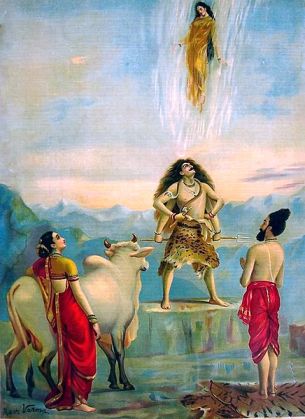
Lord Brahma ordered Ganga to go back to earth. So, Ganga followed the chariot of Bhagiratha and descended on earth. It is said that a part of her still flows in heaven in the form of the Milky Way.
In her descent, Bhagiratha was assisted by Lord Shiva. It is said that while descending on earth, she was flowing with her full force. To control her flow, Lord Shiva first blocked her in his locks, and she flowed after that in a controlled manner. This occurred at the abode of Lord Shiva, which is Mount Kailash. She, as a river, thus originates at the glaciers of this mountain and enters India after crossing a large area and merging with other rivers within herself.
Alternatively Ganga is Daughter of Lord Vishnu
According to one legend, she was born from Lord Vishnu. According to this, Lord Vishnu was in one of his incarnations as Vamana. In this form, he extended his left foot in order to end the universe. He pierced a hole in its covering with his big toe. Through this hole, the pure water of the cosmos entered the universe. This was the river Ganga. She touched the feet of Vamana before descending into the universe and settling in the abode of Lord Brahma.
Representation: Symbol of Purity
Goddess Ganga is often depicted as a beautiful, fair complexioned woman wearing a white saree with a golden border. She is also sometimes depicted with a red saree, but the white saree symbolism is predominant. The colour white depicts her purity and celestial beauty.
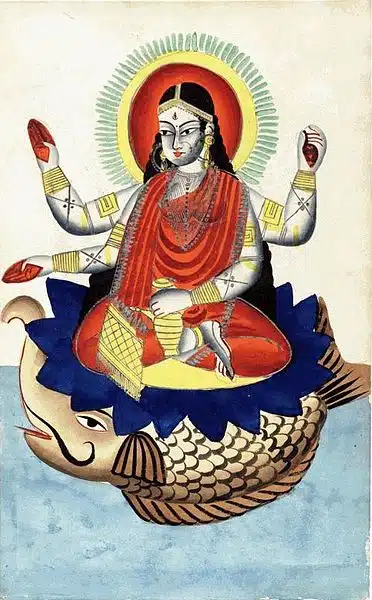
Goddess Ganga rides an animal that has the head of a crocodile and the tail of a dolphin. This mythical creature is called Makara. Makara is considered a guardian of gateway thresholds such as the entry gates of temples or the garbhagriha (inner room) of the temples. The mythical creature also symbolizes the life-affirming quality of waters and vegetation along with the wisdom of the sea and the earth. Her weapon is the Kalasha (a metal pot with a large base and small mouth).
She wears a white crown and holds a water lily in her right hand. Her left hand contains a lute. She is also sometimes shown with four arms. Her other two hands are often depicted holding an overflowing water pot and a rosary. This water pot is said to contain amrita (holy water). She is also known in various mudras such as varada (boon distribution) and abhaya (fearless).
The representation of Goddess Ganga has several versions. In some images, she is also depicted as a mermaid wearing a crown. Her forehead bears the markings of sacred ash, symbolizing her association with lord Shiva. Sometimes, she is also portrayed as a beautiful woman with the lower half of her body being flowing water.
Legends of Goddess Ganga
According to one legend, Ganga was originally one of the three wives of Lord Vishnu.Lakshmi and Saraswati are the other two. One time, Saraswati saw that Ganga was glancing at Lord Vishnu. He was sitting behind both Goddesses, Lakshmi and Saraswati. Angry Saraswati accused her of stealing all of her husband’s love. At this point, Ganga requested that Lord Vishnu help her, but he remained neutral. He said that he loved all three of them equally.
Goddess Lakshmi tried to be an intermediary to solve their quarrel. But Saraswati got angry with her too. She cursed her for being born as the Tulsi plant. Seeing this, Ganga cursed Saraswati to be reincarnated as a river on earth And Saraswati, enraged, cursed Ganga with the same curse. As a result of this curse, sinful people would bathe in her water to atone for their transgressions.
Goddess Ganga’s Marriage with King Shantanu
Goddess Ganga married king Shantanu ( ancestor of Kauravas and Pandavas). He was the ruler of Hastinapur. He once saw devi Ganga on the banks of the Ganga river and was enamored by her beauty. He proposed to the Goddess; she agreed to marry him but kept a condition.
Her condition was that King Shantanu would never question any of her decisions. If he did that, she would leave him. The king agreed and this is how the marriage of Goddess Ganga and king Shantanu of Hastinapur took place.
Mother to eight Vasus
In the Mahabharata, the Goddess is the mother of eight Vasus (attendants of Lord Vishnu). It was said that these Vasus were reincarnated because of a curse. They wanted her to kill them as soon as they were born. She accepted their request. She began drowning each son upon birth.
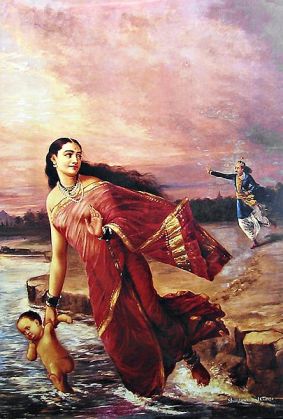
Her husband Shantunu (the incarnation of Varuna) watched the drowning of their first seven sons, but for the eighth he stopped her. She stopped, but later eloped with him. She gave Bhishma, the eighth son, back to Shantanu when he was ten. Bhishma became a warrior and was granted the wish that his death would be at his own discretion.
The Sage Jahnu Drinks All the Water of Ganga
Once, the sage Jahnu put a curse on the Goddess. When Ganga was flowing through the locks of Lord Shiva, her flow was controlled. But she was still in her youth. Her water was still flowing with great force. Sage Jahnu’s fields were destroyed because of her. Infuriated, the sage drank up all the water of Ganga. The Gods prayed to him to release the holy water for the good of mankind. So, he finally released her through his ear. This legend gave her the name Jahnavi, which means “daughter of Jahnu.”
Parvati is Mother to Kartikeya
According to one story, after the marriage of Lord Shiva and Parvati, they still didn’t have any children for many years. All the Gods were worried about the power of their child, which was about to be born. They thought that the power of a child born out of such a union would be immense. Lord Shiva and Goddess Parvati’s radiance could endow their child with unlimited power that, if unchecked, could destroy all three worlds.
All gods thus requested Lord Shiva to do a ritual. Accordingly, Lord Shiva discharged his seed, which, along with forests and mountains, got inseminated. The fire god and wind god also helped in the process. Thus, Kartikeya was born.
However, as Goddess Parvati desired to give birth to their child on her own. Angry at the plan of the gods, she cursed all of them. Thus, they were not going to be able to get their children through their wives. As their wives were to remain infertile. She also cursed the earth, saying that she would be the wife of many but have no children.
Ganga is Mother to Skanda
According to the Skanda Purana, Goddess Ganga is the foster mother to Skanda or Kartikeya, the son of lord Shiva and Devi Parvati.
According to legend, she and Lord Shiva went to the Himalayas and started doing penance. All the gods went to Lord Brahma, as there was no commander of their army, Lord Shiva being with Parvati. Lord Brahma said that the fire god would soon have a child with Goddess Ganga. All the gods went to Fire God with the request, and Fire God went to Ganga. He expressed his desire to have a son with her. She agreed and adopted her divine form as a river. The Fire-god drenched the goddess with the radiance of Lord Shiva.
But she couldn’t hold the baby because it was so strong. Seeing her miserable power, the fire-god told her to hide the embryo at the bottom of the Himalayas. The place where it was hidden became a place of gold. The boy born out of the embryo then became the chief of the army of gods. He was known by the name Skanda. He quickly grew into a warrior, defeating the Asuras. Legend has it that Kartikeya or Skanda was also known as Kumara, the son of Ganga.
Manifestations
Goddess Ganga is manifested in the form of a river. She has seven branches. At the start of her flow, she is known as Mandakani. Along with this, she is Bhagirathi, Jahnvi, Bhilangana, Rishiganga, Saraswati, and Alaknanda. After merging with the rivers Yamuna and Brahmaputra, she becomes Padma and finally merges with the ocean as Meghna.
Devotion
People bathe in the Ganges, believing that doing so will wash away all their sins. Hence, their karma will get clearer, and they will be closer to moksha in this birth. As a river, she symbolizes fertility and is an important part of the whole life process.
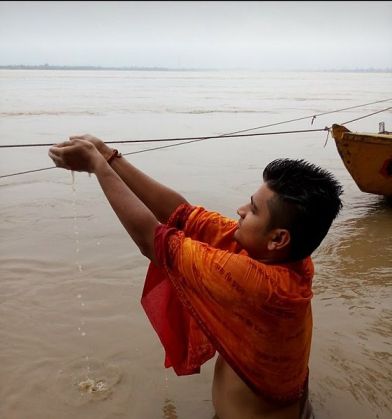
Her worshippers call her Ganga Maiya, which means they see her as a mother figure. People also immerse the ashes of their kin in the river. This is done to make them closer to moksha after death. It is also considered the completion of a cycle. Because all things arise from natural elements, they should continue to exist in these elements after death.
She is worshiped during one of the days of Navratri. Other festivals, such as Ganga Jayanti, are celebrated to honor her. There are many important places, such as the banks of the river in Haridwar, Prayagraj, and Varanasi, where her puja is done with all the decorations and mantras. Kumbh Mela, which is one of the largest festivals in the world, is celebrated on the banks of the river Ganga. People from all over the country and the world come to see the grand ceremonies held in her honor.
Maa Ganga has immense spiritual significance for Hindus. Many auspicious rituals such as the mundan ceremony of a child ( a Hindu ceremony in which the child’s hair is cut off for the first time) take place on the banks of river Ganga. It is believed that any ritual performed on its banks will be blessed by Ganga Maiyya herself.
Some places situated on the banks of Ganga have additional spiritual significance such as Gangotri, Uttarkashi, Gaumukh, Haridwar, Rishikesh, Varanasi, Prayajraj,etc.
Asthi Visarjan (Immersion of Ashes ) by the Ganga
In Hinduism, the cycle of birth and death are interconnected. According to Hindu beliefs, the soul attains moksha or salvation only when it is released from the constant cycle of birth and death. The ultimate aim of every soul is to get rid of the material cycle of life and death, and attain liberation or enlightenment.
Many cremation ceremonies take place on the ghats of river Ganga. Some Ganga ghats are specially reserved for this purpose. For example, the Manikarnika ghat in Kashi is used only for cremation. Such ghats exist in Haridwar and Rishikesh as well. It is believed that if the cremation takes place from these holy ghats, the soul of the departed ascends to heaven and ultimately attains salvation.
The ritual of Asthi Visarjan is the most important ritual connected to death in Hinduism, The ashes of the deceased are immersed into the holy waters of Ganga, thus paving the way for their moksha or salvation.
Kumbh Mela
According to the legend of the Samundra manthan ( divine churning of the oceans), Haridwar is considered one of the sites where drops of Amrit or the nectar of immortality accidentally spilled from the pitcher while being carried away by the demons.
Thus, Kumbh Mela is celebrated every 12 years on the banks of Maa Ganga rotating between the pilgrimage sites of Haridwar, Prayagraj, Nashik, and Ujjain. During this time, millions of devotees, pilgrims and tourists gather in Haridwar to take the ritualistic bath on the banks of Ganga river to wash away their sins and attain moksha or salvation.
An important aspect of Kumbh Mela is the participation of sadhus(holy men) from various akhadas and ashrams of Hinduism. Different akhadas have their own spiritual philosophies and rituals so their participation is an important aspect of passing the knowledge and skills related to Kumbh Mela.
Ganga Dussehra
Also known as Gangavataran, Ganga Dussehra celebrates the descent of Goddess Ganga from the matted locks of lord Shiva onto the earth.
It is celebrated on the tenth day of Jyeshthah (last week of May) according to the Hindu calendar. The first ten days of the month of Jyeshthah are dedicated to honor Maa Ganga.
On this day, people take a dip into the holy waters of river Ganga to get rid of all their sins and pave the way for moksha or enlightenment. The number 10 is considered very auspicious this day as the devotees have to follow puja rituals that involve lighting of 10 diyas and giving daan(offerings ) to 10 Brahmins. It is believed that a person gets pardoned from 10 different kinds of sins by taking a dip into the holy waters of Ganga maa on this day.
Kanwar Yatra
The famous Hindu pilgrimage of Kanwar Yatra involves the worship of both lord Shiva and Goddess Ganga.
It’s celebrated in the month of Savan(usually in July) according to the Hindu calendar. During this festival, devotees of lord Shiva known as Kanwariyas carry the holy water of Ganga maa on their shoulders and then travel to various Shiva temples to offer that water to the shivlinga.
Symbols
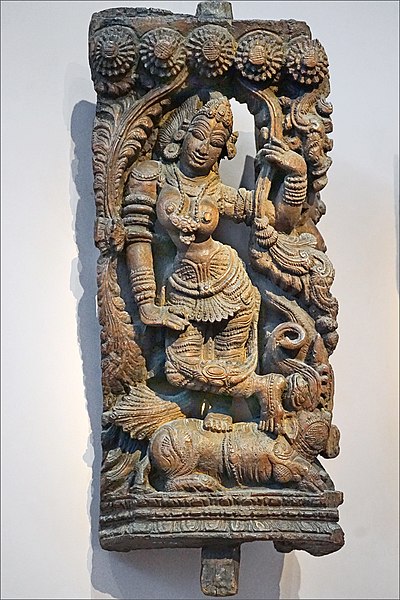
Colors/Elements
Water: Ganga is the goddess representing holy water.
Yellow: Worshipers of Goddess Ganga offer her yellow flowers during the puja ceremony.
Plants
Rice: It is believed that offering rice or other delicacies to the goddess Ganga will bring happiness and fortune.
Animals
Crocodile: Goddess Ganga travels on a creature similar to a crocodile.
Perfumes/Scents
Saffron: Along with rice, devotees also offer saffron to Goddess Ganga.
Sandalwood: Sandalwood has a soothing effect on people, just like Goddess Ganga does as a mother.
Gems and Metals
Kumbha: It is a type of pottery in India. It looks similar to a womb and is thus a symbol of fertility. It is often associated with Goddess Ganga.
FAQs about Ganga
The goddesses Ganga and Parvati are both daughters of King Himavat. Ganga, being the firstborn, is the elder sister of Parvati.
Ganga symbolizes purity and forgiveness. She is regarded as the mother of all.
Sage Bhagirath, through his severe penance, helped in her descent with the aid of Lord Shiva.
Goddess Ganga gave birth to eight Vasus, and warrior Bhishma was one of them.
Other Goddesses
If you enjoyed this post we are sure you will enjoy getting to know some of the other goddesses we also write about. You can find the complete list of goddesses sorted across regions and religions here.
Gallery
- Ganga presenting her son Devavrata (the future Bhishma) to his father, Shantanu
- Ganga stone statue, 8th century AD, Ellora. Currently at National Museum, New Delhi, India.
- Goddess Ganga, Patan Durbar Square
- Goddess Ganga, Kelaniya Raja Maha Vihara
- Shiva breaks Ganga’s fall in the coils of his hair, lintel in Thommanon.
- Statue of Goddess Ganga at Ganga Talao in Mauritius
Featured Image Credit: AKS.9955, CC BY-SA 4.0, via Wikimedia Commons

